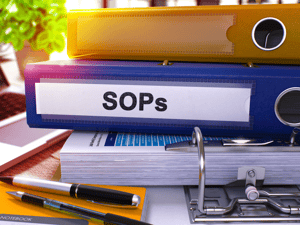Posted by Molly Fisher ● March 22, 2022
SOP Training: 4 Tips to Make Your SOPs Immediately More Effective
 Standard operating procedures. Every company has them. Not everyone follows them. If your company struggles with adherence to SOPs, read on to see how SOP training can help get your workers on the same page.
Standard operating procedures. Every company has them. Not everyone follows them. If your company struggles with adherence to SOPs, read on to see how SOP training can help get your workers on the same page.
A standard operating procedure (SOP) is a set of instructions designed to help workers carry out routine tasks or operations.
Companies use SOPs for a variety of reasons ranging from legal regulations to efficiency needs. SOPs come in many forms, including lengthy, text-based documents, bulleted lists, or step-by-step diagrams.
SOPs are mission-critical assets for almost every company. They codify a business’s most important processes, ensuring tasks get done the same way every time, no matter who is performing them. Without SOPs, things like safety, product quality, service quality and profitability are harder to control.
The Problem with SOPs
SOPs are great in a vacuum. When followed, they help companies with compliance, safety, efficiency and profitability. But the problem is, not everyone follows SOPs to the letter—especially when the SOP is either hard to understand or not well-communicated.
When SOPs aren’t followed it creates confusion and inconsistencies that can affect the quality of work. That could mean legal or financial issues down the line.
One way to ensure adherence is with an effective SOP training initiative. Training can help make sure that your SOPs are well-communicated, understood and followed—but only if it’s good training. Here are some tips on how to create effective training around your SOPs.
4 Tips to Creating Effective SOP Training
SOP training needs to be engaging to be effective. The more engaged your workers are in the training, the more likely they are to retain the information and follow the SOP moving forward.
When developing training around SOPs, don't rush. Take the time to make sure you:
- Let the content drive the instruction
- Simplify and explain complex language
- Use microlearning whenever possible
- Explore multimedia elements
#1) Let the Content Drive the Instruction
The instructional format you choose will depend on the content of the SOP or the procedure being taught in the training.
SOP training in customer service procedures should be very different than SOP training around a manufacturing process. Let the content guide you on how best to design your instruction around the SOP.
#2) Simplify Complex Language
SOP documents can be dry, wordy and hard to understand, let alone follow. Make sure your training addresses this by simplifying and explaining the language.
Couch complex concepts in terms workers can understand. Explain how and why each step in the SOP is essential to their job. A human touch goes a long way when it comes to demystifying operational documentation.
#3) Use Microlearning
SOP training is perfect for a microlearning format. In microlearning, you split the training up into bitesize chunks that are no longer than five minutes.
Your workers are likely very busy and have packed schedules. Mini modules make your SOP training content more accessible, allowing people to take things one step at a time.
Microlearning also makes the material easier to retain. In those hours-long training sessions, people rarely remember every topic covered. It’s much easier to retain the material from a quick training module.
#4) Explore Multimedia Elements
Whenever possible, make sure you’re incorporating several forms of media into your SOP training program. Multimedia training helps your learners stay engaged and helps you figure out which ways your team likes learning best.
Case in point, a step-by-step video might be a better way to communicate the salient points of a wordy SOP doc. It also doubles as a record of the procedure for new hires or if anyone wants to go back and watch it again.
Don’t Forget to Measure Success
SOP training isn’t a one-time project. It requires regular follow-up to make sure it’s working. The most effective way to do this is by observation. Ultimately with SOPs, you need to see your workers referencing and using your SOPs for the training to be considered a success.
You can also take the time to tie the training back to a relevant metric. If the SOP is concerned with increasing customer satisfaction, you can gauge the average satisfaction rating before and after the training to see if people retained and are now using the SOP.
You can also use these metrics to decide on the effectiveness of the SOP itself. If workers are using the training and you’re not seeing improvements, then maybe the procedures need updating.
Conclusion
It takes time and effort to create and reinforce SOP training, but the outcomes are worth the effort. Your workers will be more equipped to follow SOPs moving forward, and you’ll reap the benefits of the increased efficiency and compliance.
Topics: Instructional Design, Compliance Training, Training and Facilitation, Blended Learning
